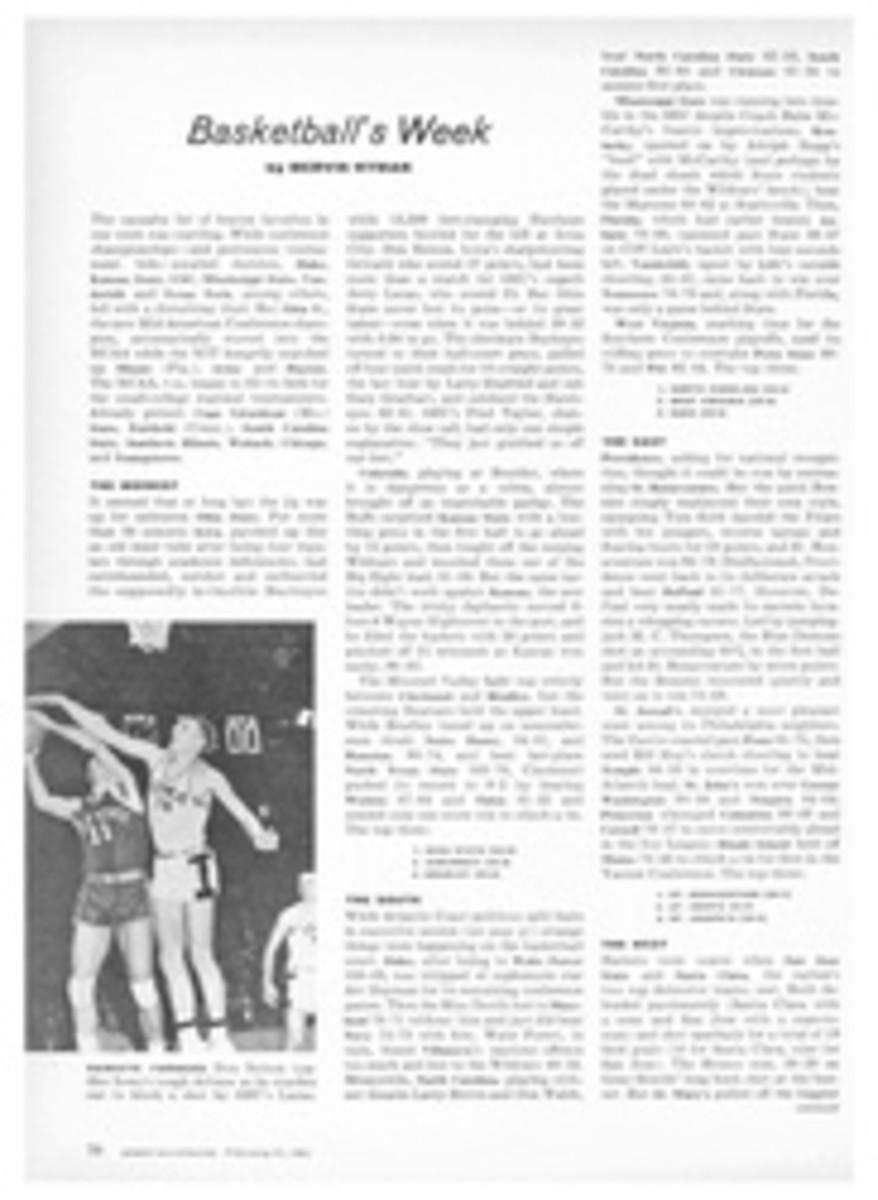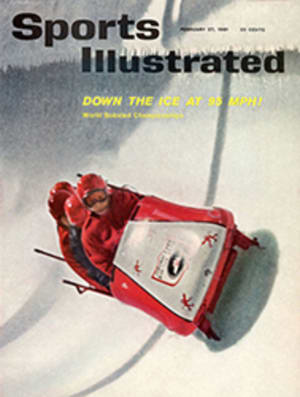
Skinny and his hoper
During the 1945-46 basketball season, an improbable 5 foot 10½ inch, 140-pound center named Ernie Calverley led a fast, high-scoring Rhode Island State team to a record of 18-2. Calverley regularly gave away a foot or more to opposing centers. But he could jump, he could dribble, he had an abundance of basketball poise and—best of all—he could shoot. He shot with either hand, with both hands and, it sometimes seemed to the opposition, with no hands. He scored over 1,800 points in his four-year varsity career, including a nation-leading 534. as a sophomore two seasons before.
Calverley was the man who generated the Rhode Island State Rams' exciting race-horse style of offense. It worked so well, even after the regular season was over, that the Rams found themselves in the championship finals of the National Invitational Tournament against the mighty Kentucky Wildcats. Featuring All-America Jack Parkinson, strong-shooting Wah Wah Jones and a flashy freshman named Ralph Beard, Kentucky had been seeded first in the NIT and was an 11½ point favorite in its game with Rhode Island.
Both teams were used to scoring heavily, but in their championship game the points came slowly and rarely. Rhode Island's run-and-shoot offense was slowed down by the Kentucky defenders, and the Wildcats elected to play a deliberate weave, taking only good shots.
The game went down to the final 40 seconds, tied at 45-45. Then Calverley fouled Beard. Beard stepped to the line and calmly flipped in the free throw. Rhode Island got the ball but couldn't get off another shot, and Kentucky won 46-45.
It was Calverley's only mistake of the tournament, and it cost Rhode Island the championship. But what was remembered about that surprising series was less Rhode Island State's loss than the fact that they were in the finals at all. For despite the brilliance of Calverley and his team's outstanding record, Rhode Island was lightly thought of by the experts when the NIT started. The team was unseeded and almost uninvited (they had been the last to be chosen).
Rhode Island lacked height. Its biggest man was 6-foot l½-inch Bob Shea, and in that first postwar year, giants such as St. John's Harry Boykoff (6 feet 9), De Paul's George Mikan (6 feet 10) and Oklahoma A&M's Bob Kurland (7 feet) had already started to dominate the game.
Rhode Island's first opponent of the tournament, on March 14, 1946, was Bowling Green of Ohio. Centered by one of the biggest giants of them all—6-foot 11½-inch Don Otten—Bowling Green was a crushing favorite to eliminate the Rams at once. When the hulking Otten, 13 inches taller and 110 pounds heavier than Calverley, stood next to the Rhode Islander in the middle of Madison Square Garden, the large crowd (a record 18,458) gasped. "The big fellow figures to enjoy a field day under the basket," commented one reporter.
The pattern of the game was set right from the start. It was Bowling Green feeding Otten underneath for short layups against the long shooting of Rhode Island's Shea, Al Nichols and Calverley. Bowling Green seemed only to lean for their rebounds: Rhode Island had to vault. But the Rams vaulted high enough, made enough one-handed shots and had enough speed to lead, 35-34, at half time.
In the second half, with Calverley directing play, Rhode Island still hung on, desperate for every break. Bowling Green simply concentrated on feeding Otten, and it seemed that their superior strength and size would soon wear down the Rams.
The lead bounced back and forth, the score was tied seven times. With three minutes left, Otten, who scored 31 points, fouled out. With only five seconds left and the score tied for the eighth time, Bowling Green made a basket to go ahead 74-72. Rhode Island immediately called a time-out.
"We sagged in the middle of the floor," recalled Calverley recently. "We couldn't talk to the coach on the sidelines as the players do today. Everybody was mumbling together. We finally decided I would throw up a hoper." Calverley explained that a hoper was a long shot "with a lot of prayer on it."
Rhode Island put the ball in play from its own backcourt. It was thrown to Calverley near the Bowling Green free-throw line. He quickly heaved the ball toward the basket at the far end of the court.
"It was a regular two-handed set shot. It might have looked like an underhanded shot to a lot of people because I threw it with a leap, but it wasn't," said Calverley.
The ball had a perfect arch. It was straight enough, and it was high enough. "While it was going through the air," Calverley said, "I was wondering if it had enough distance. What a pleasant sound when it cracked the cords! I was as surprised by it as the next guy."
The ball had traveled almost three quarters the length of the court. It was reported as the "longest, most amazing shot ever made at the Garden." It was later measured, according to Calverley, as 58 feet. It tied the score for the ninth time just as the buzzer sounded.
The overtime period was almost an anticlimax to Calverley's heroic shot. Rhode Island State won 82-79, and six days later, nearly pulled off the biggest upset in NIT championship history.
PHOTO
LITTLE ERNIE CALVERLEY DRIBBLES BY KENTUCKY'S WAH WAH JONES IN THE NIT FINALS
PHOTO
CALVERLEY LEAPS HIGH TO SHOOT BALL

